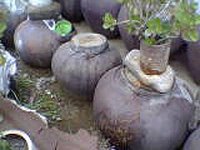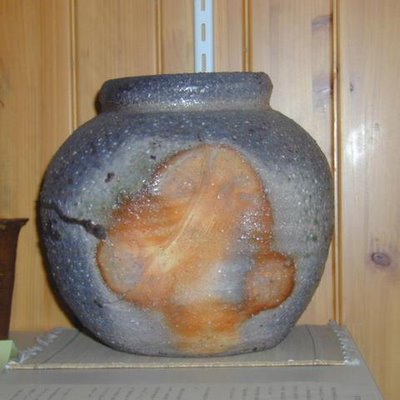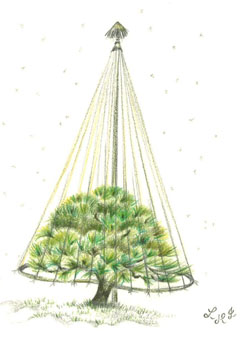[ . BACK to Worldkigo TOP . ]
:::::::::::::::::::::::::::::::::::::::::::::::::::::::::::::::::::::::::::::::::::::::::::::::::::::
Plum Blossoms (ume)
***** Location: Japan, other countries
***** Season: Early Spring, others see below
***** Category: Plant, others see below
*****************************
Explanation

Next to the Cherry blossom, the plum blossoms are loved by Japanese poets and where enjoyed even more than the cherry in the Heian peroid.
They are a symbol of refinement, purity and nobility and also a reminder of past love.
Sugawara Michizane was especially known for his love of the plum blossoms shared in many Tanka poems. More about him below.
Ume, Prunus mume, is biologically of the apricot family.
For kigo of other seasons related to the
plum fruit, see below.
quote
The plum blossom, which is known as the meihua (梅花), is one of the most beloved flowers
in China and has been frequently depicted in Chinese art and poetry for centuries.
The plum blossom is seen as a symbol of winter and a harbinger of spring. The blossoms are so beloved because they are viewed as blooming most vibrantly amidst the winter snow, exuding an ethereal elegance, while their fragrance is noticed to still subtly pervade the air at even the coldest times of the year.
Therefore the plum blossom came to symbolize perseverance and hope, but also beauty, purity, and the transitoriness of life.
In Confucianism, the plum blossom stands for the principles and values of virtue. More recently, it has also been used as a metaphor to symbolize revolutionary struggle since the turn of the 20th century.
Because it blossoms in the cold winter, the plum blossom is regarded as one of the
"Three Friends of Winter", along with pine, and bamboo.
poet Lin Bu (林逋) of the Song Dynasty (960–1279)
When everything has faded they alone shine forth,
encroaching on the charms of smaller gardens.
Their scattered shadows fall lightly on clear water,
their subtle scent pervades the moonlit dusk.
Snowbirds look again before they land,
butterflies would faint if they but knew.
Thankfully I can flirt in whispered verse,
I don't need a sounding board or winecup.
As with the literary culture amongst the educated of the time, Lin Bu's poems were discussed in several Song Dynasty era commentaries on poetry.
JAPAN
Japanese tradition holds that the ume functions as a protective charm against evil, so the ume is traditionally planted in the northeast of the garden, the direction from which evil is believed to come.
The eating of the pickled fruit for breakfast is also supposed to stave off misfortune.
© More in the WIKIPEDIA !
:::::::::::::::::::::::::::::::::::::::::::::::::::::::::::::::::::::::::::::::::::::::::::::::::::::
More kigo with the plum blossoms
ume 梅 (うめ) plum (blossom)
white plum blossom, hakubai 白梅 (shira-ume)
wild plum blosoms, yabai 野梅
plum with hanging branches, shidare ume 枝垂れ梅
old plum tree, roobai 老梅
. red plum blossom, koobai 紅梅
mikai koo 未開紅(みかいこう)not yet open red
usukoobai 薄紅梅(うすこうばい)light red plum
bonbai 盆梅(ぼんばい)
bonsai tree of a plum
garyoobai 臥龍梅(がりょうばい
)"lying down dragon plum tree"
its blossoms are slightly pink.
. . . CLICK here for Photos !
seiryoobai 青龍梅(せいりゅうばい
)"green dragon plum tree"
usually an old tree with a gnarled trunk
. . . CLICK here for Photos !
tobiume, tobi-ume 飛梅(とびうめ
)"flying plum"
a tree which Michizane planted himself, according to legend, in Dazaifu.
ooshukubai 鶯宿梅(おうしゅくばい
)"plum which houses nightingales"
short for "uguisu no yadoru ume" 鶯(うぐいす)の宿る梅
Legend says, it was planted in the home of the daughter of Ki no Tsurayuki 紀貫之 at the time of Murakami Tenno (926 - 967).
. Ki no Tsurayuki 紀貫之 and the Plum .
.................................................................................
plum plantage, plum park, bairin 梅林
plum park, baien bai-en 梅園
plum blossoms in the last snow, zansetsu bai 残雪梅(ざんせつばい)
plum blossoms in the last moon, zangetsu bai 残月梅(ざんげつばい)
village with plum blossoms, ume no sato
梅の里(うめのさと)
home with plum blossoms, ume yashiki 梅屋敷(うめやしき)
lodging with plum blossoms, ume no yado 梅の宿(うめのやど)
owner of a plum blossom grove, ume no aruji 梅の主(うめのあるじ)
Fragrance, smell of plum blossoms (ume ga ka 梅が香(うめがか)
Talking about a white plum blossom the reader will still feel the cold of winter, while a red blossom implies the warmth of spring.
The
fragrance of the plum (ume ga ka 梅が香) brings fond memories and an old plum tree refers to old age and loneliness. Just
one flower on a tree ume ichirin (梅一輪)or one all white flower (umemasshiro, 梅真っ白)well that seems like a fair maiden.
The
plum blossom viewing (ume-mi, kan-bai 梅見、観梅) is more of an individualistic endeavor, different from the noisy, crowded cherry blossom parties. Many temples and famous estates have a special ground for plum blossom viewing (see below).
plum blossom viewing in the evening, yoru no ume
夜の梅(よるのうめ)
plum blossom viewing in the dark, yami no ume 闇の梅(やみのうめ)
.................................................................................
kigo for late winter
early plum blossoms, soobai 早梅 (そうばい)
..... ume hayashi 梅早し(うめはやし)
..... hayazaki no ume 冬 早咲の梅(はやざきのうめ)
winter plum blossoms, fuyu no ume 冬の梅(ふゆのうめ)
kanbai 寒梅 (かんばい)
plum blossoms in the cold
kankoobai 寒紅梅(かんこうばい) red plum blossoms in the cold
. . . . .
toojibai 冬至梅 (とうじばい)
plum blossoms at the winter solstice
kigo for mid-winter
. . . . .
. muro no ume 室の梅(むろのうめ) plum blossoms in the greenhouse
kigo for all winter

also the name of a sweet set for winter tea ceremony.
.................................................................................
"month for plum blossom viewing", umemizuki
梅見月(うめみづき)
..... umetsusazuki 梅つさ月(うめつさづき)
now march
kigo for mid-spring
.................................................................................
hassakubai, hassaku bai 八朔梅 (はっさくばい)
plum blossom on the first of August
..... karakurenai からくれない
kigo for mid-autumn
This is a kind of red plum which double red blossoms (yae) in autumn, it was introduced from China.
:::::::::::::::::::::::::::::::::::::::::::::::::::::::::::::::::::::::::::::::::::::::::::::::::::::
Famous Plum parks in Japan
The Kairaku-En Park in Mito is the most famous, I guess, for Plum Viewing.
The famous Feudal Lord, Mito Komon loved plums very much (for their medical purposes, I guess). Plum trees have been introduced to Japan via China as a medicine quite a long time ago.
Plum Festival in Mito, Kairaku-En Park 水戸偕楽園
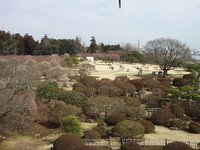 http://www.mitokoumon.com/maturi/ume/ume.htm
http://www.mitokoumon.com/maturi/ume/ume.htm
http://homepage3.nifty.com/kazu_kawamura/kairakuen.html
http://homepage3.nifty.com/kazu_kawamura/kairakuen2.html
http://ww7.tiki.ne.jp/~inabah/deki0013.htm
http://www.geocities.co.jp/Hollywood-Miyuki/6603/umemi.html
http://www4.zero.ad.jp/ucchy/other/other/kannbai/kanbai.htm

fusuma sliding door at Kobuntei, Kairaku-en
under plum blossoms
and the full moon
sleep paces til dawn
- Shared by Kit Nagamura -
Haiku Culture Magazine, 2013
.............................................................................
Yugawara Plum blossom Festival
 http://fine.tok2.com/home/nakae/nikki/2003/20030302/page0001.htm
Atami Plum Festival, Ume-matsuri
梅まつりA →
http://fine.tok2.com/home/nakae/nikki/2003/20030302/page0001.htm
Atami Plum Festival, Ume-matsuri
梅まつりA → Plum Viewing
梅まつりB → Plum Viewing
More Plum Viewing
With a waterfall at the entrance of the park
http://www2.tokai.or.jp/triangle/atami-ryojyou/a-atamibaien1409/baien1409/b-umeminotaki.htm
http://www2.tokai.or.jp/triangle/atami-ryojyou/a-atamibaien1409/baien1409/samuneiru.html
Look at this Plum Viewing Park in Kume Town,
very near my home.
taking a nose walk
in the plum park -
Kume no Sato
Gabi Greve, 2006
:::::::::::::::::::::::::::::::::::::::::::::::::::::::::::::::::::::::::::::::::::::::::::::::::::::
When the east wind blows,
Send me your perfume,
Blossoms of
the plum:
Though your lord be absent,
Forget not the spring.
-
Sugawara Michizane
trs. G. Bownas A. Thwaite
http://www.ahapoetry.com/ahalynx/172bkrv.htm
*****************************
Worldwide use
Kenya
Plum Fruit
:::::::::::::::::::::::::::::::::::::::::::::::::::::::::::::::::::::::::::::::::::::::::::::::::::::
Taiwan
Mount Yangming, Yang-ming shan and plum blossoms
*****************************
Things found on the way
All about Sugawara Michizane and the Tenmangu Shrines.
observance kigo for early spring,
refering to the PLUM in memory of Michizane
Kitano Baikasai 北野梅花祭(きたのばいかさい)
Plum festival at the Kitano Shrine
baiga goku 梅花御供(ばいかごく)
memorial service in the plum blossom time
:::::::::::::::::::::::::::::::::::::::::::::::::::::::::::::::::::::::::::::::::::::::::::::::::::::
Prune
A prune is a dried fruit of various plum species, mostly Prunus domestica. It is wrinkly in shape, unlike its non-dried counterpart.
© wikipedia
The German ZWETSCHGE is also a different fruit.
*****************************
HAIKU
 plum blossoms
plum blossoms
and Daruma dolls –
the Joys of Japan
Join the poetry group on FB by clicking on the image.
:::::::::::::::::::::::::::::::::::::::::::::::::::::::::::::::::::::::::::::::::::::::::::::::::::::
even the heavenly gods
crowd' round
plum blossoms
Kobayashi Issa
Tr. David Lanoue
:::::::::::::::::::::::::::::::::::::::::::::::::::::::::::::::::::::::::::::::::::::::::::::::::::::
ume ichi-rin ichirin hodo no atatakasa
..... Hattori Ransetsu (1654-1707)
one plum blossom
brings us just one more
step to the warmth
(Tr: Gabi Greve)
Read more about this famous haiku
and look at one plum blossom.
:::::::::::::::::::::::::::::::::::::::::::::::::::::::::::::::::::::::::::::::::::::::::::::::::::::
. Yosa Buson 与謝蕪村 in Edo .
 白梅に明くる夜ばかりとなりにけり
白梅に明くる夜ばかりとなりにけり
shira ume ni akuru yo bakari to nari ni keri
The night almost past,
through the white plum blossoms
a glimpse of dawn.
source : Dave Bonta
pure white plum blossoms
slowly begin to turn
the color of dawn
source : online reference
This haiku has the cut marker KERI at the end of line 3.
白梅や誰が昔より垣の外
shiraume ya taga mukashi yori kaki no soto
(1775)
A white apricot tree--
From whose old days
Outside the fence?
Tr. Nelson/Saito
- - - - -
sooan 草庵
at my grass hut (humble dwelling)
二もとの梅に遅速を愛す哉
futamoto no ume ni chisoku o aisu kana
My two plum trees are so gracious . . .
see, they flower
One now, one later
Tr. Peter Beilenson
Two ume trees in my garden
Bloom at a different time;
How dear the difference!
Tr. Shoji Kumano
Two flower branches of plum,
one early, on late,
oh deeply loved.
Tr. Sawa/ Shiffert
The cut marker KANA is at the end of line 3.
This poem might refere to a Chinese poem mentioned in the collection Wakan Roeishu.
Two willow trees are dropping their leaves at different times.
Wakan Rōeishū 和漢朗詠集
Collection of Japanese and Chinese Poems for Singing
- reference : wikipedia -
- - - - -
梅遠近南すべく北すべく
ume ochikochi minami subeku kita subeku
Plum flowers far and near.
Shall I go to the south?
Shall I go north?
Tr. Sawa/ Shiffert
. Buson and the Four Directions .
白梅や墨芳しき鴻臚館
hakubai ya sumi kanbashiki koorokan
White plum flowers!
The fragrance of an inkstone
in the Chinese guesthouse.
Tr. Sawa/ Shiffert
. Koorokan 鴻臚館 Koro-Kan, Chinese Guesthouses .
for embassies from China and for Japanese on their way to China
うぐいすや梅踏みこぼす糊盥
. uguisu ya ume fumikobosu nori darai .
noridarai 糊盥 glue tub
. Yosa Buson 与謝蕪村 in Edo .
- MORE at terebess
hi o okade hito aru sama ya ume no yado
kanbai o taoru hibiki ya oi ga hiji
minomushi no furu su ni soute ume nirin
mizu ni chirite hana nakunarinu kishi no ume
mukutsukeki boku tomo shitaru ume-mi kana
mume no ka no tachinoborite ya tsuki no kasa
shirami toru kojiki no tsuma ya ume ga moto
shiraume ni akuru yo bakari to nari ni keri
shiraume no kareki ni modoru tsukiyo kana
sumizumi ni nokoru samusa ya ume no hana
ume chiru ya raden koboruru taku no ue
ume ga ka ni yugure hayaki fumoto kana
ume ga ka no tachinoborite ya tsuki no kasa
ume orite shiwade ni kakotsu kaori kana - wrinkled hands
ume sakite chiisaku narinu yuki maroge - snowman
 青梅に眉あつめたる美人哉
青梅に眉あつめたる美人哉
ao ume ni mayu atsumetaru bijin kana
Among green plums trees.....
a lovely beauty gathering
her eyebrows up!!
So, why is this beautiful woman gathering her eyebrows up?
One of the haiku readers I have says that although Masaoka Shiki and Takahama Kyoshi read this action as meaning that the girl had eaten one of the very sour green fruits that the plums grow, Buson probably had the legendary Chinese beauty Xi Shi in mind when he wrote the haiku.
The book '蕪村と漢詩' (
Buson and Chinese Poetry) takes the Chinese connection further by arguing that Buson is alluding to a short poem by the poet Li Bai (李白), titled 'Resentment', that has a women roll up the curtain to her window, gather her eyebrows up and start crying. The use of the present participle here brings out the allusion because it describes the woman as being in the act of knitting her eyebrows, which then returns us to Li Bai's poem to fill out the image with the fact that she is about to cry.
The link gives a translation and a reading of the original poem:
http://www.chinesetolearn.com/tang/
- Tr. and comment : James Karkoski / facebook -
Looking at green plums
a beauty pulls a face
as she recalls how sour they are.
Tr. Sasaki, McCabe, Iwasaki
in the book "Chado: The Way of Tea"
:::::::::::::::::::::::::::::::::::::::::::::::::::::::::::::::::::::::::::::::::::::::::::::::::::::
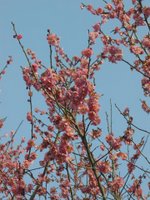
koobai ni miageru sora no aosa kana
between red plum blossoms
looking at the sky
so blue, so blue!
© Photo and Haiku, Gabi Greve
ume ichirin kao ni kakarishi Amida kana
.. .. .. .. .. one plum blossom
.. .. .. .. .. clinging to the face
.. .. .. .. .. of a stone Buddha
..... Gabi, Kamakura Tookei-ji Temple, 1991
For details about Amida Nyorai, check this link
http://www.onmarkproductions.com/html/amida.shtml
:::::::::::::::::::::::::::::::::::::::::::::::::::::::::::::::::::::::::::::::::::::::::::::::::::::
 learning from the plum -
learning from the plum -
never give up
spring blossoming
The tree in my garden is so crooked and full of greenish moss, so old and fragile during winter
> > > AND YET
> > > come spring
> > > come blossoms
© Photo and Haiku by Gabi Greve
:::::::::::::::::::::::::::::::::::::::::::::::::::::::::::::::::::::::::::::::::::::::::::::::::::::
old plum tree
the road crew unloads
a bulldozer
Laryalee Fraser, WHCworkshop
:::::::::::::::::::::::::::::::::::::::::::::::::::::::::::::::::::::::::::::::::::::::::::::::::::::
Japanese Haiku about the Plum
梅,梅林,白梅
*****************************
Related words
***** green plum, ao-ume, ao ume 青梅 (the fruit),
ume no mi, mi-ume 梅の実、実梅
niume, ni ume 煮梅(にうめ)boiled plum
Bungo ume 豊後梅(ぶんごうめ)plum from Bungo
Shinano ume 信濃梅(しなのうめ)plum from Shinano
Kooshuu uma 甲州梅(こうしゅううめ)plum from Koshu
koume 、小梅(こうめ)small plum
miume, mi ume 実梅(みうめ) fruit of the plum tree
kigo for mid summer
. 金剛寺の青梅 Kongo-Ji no Ome .
The name Ome comes from just one plum tree. It had fruit which stayed green until autumn and never changed color.
People thought this very strange and called the tree
"green plum tree" - ao ume 青梅, soon shortened to Ome.
There is a legend linking this strange plum tree to Taira no Masakado.
:::::::::::::::::::::::::::::::::::::::::::::::::::::::::::::::::::::::::::::::::::::::::::::::::::::
 dryed plums,ume boshi 梅干 (うめぼし)
dryed plums,ume boshi 梅干 (うめぼし)
..... hoshi ume 干梅(ほしうめ)
kigo for all summer
to dry plums, ume hosu 梅干す(うめほす)
to pickle plums, umezuke 梅漬(うめづけ)
..... ume tsukeru 梅漬ける(うめつける)
mat to spread plums to dry, ume mushiro 梅筵(うめむしろ)
Umeboshi (literally "dried ume") are pickled ume fruits. Ume is a species of fruit-bearing tree in the genus Prunus, which is often called a plum but is actually more closely related to the apricot. Umeboshi are a type of tsukemono, or traditional Japanese pickled food, and are very popular in Japan.
© More in the WIKIPEDIA !
. WASHOKU : umeboshi, pickled plums
:::::::::::::::::::::::::::::::::::::::::::::::::::::::::::::::::::::::::::::::::::::::::::::::::::::
tanbai 探梅 (たんばい) looking for plum blossoms
searching for plum blossoms
..... ume saguru 梅探る(うめさぐる)
tanbaikoo 探梅行 (たんばいこう) excursion to seek plum blossoms
shunshin 春信(しゅんしん)spring is coming soon, signs of spring
haru no tayori 春の便り(はるのたより) message from spring
kigo for late winter
:::::::::::::::::::::::::::::::::::::::::::::::::::::::::::::::::::::::::::::::::::::::::::::::::::::
umemi, ume-mi 梅見 (うめみ) viewing plum blossoms
..... kanbai 観梅(かんばい)
 Mizuno Toshikata
Mizuno Toshikata 水野年方 (1866 - 1908)
umemijaya 梅見茶屋(うめみぢゃや)tea house for watching plum blossoms
Viewing plum blossoms was most popular in olden times, even more popular than viewing cherry blossoms (hanami).
kigo for early spring (humanity)
.SAIJIKI ... HUMANITY
Kigo for Spring
.................................................................................
observance kigo for early spring
February 11
baikasetsu 梅花節 / 梅佳節(ばいかせつ)
"plum blossom season"
Kenkoku kinenbi 建国記念日 (けんこくきねんび)
National Foundation Day of Japan
..... kenkoku no hi 建国の日(けんこくのひ)
..... kenkoku sai 建国祭(けんこくさい)
kigensetsu 紀元節(きげんせつ)
This is listed as a kigo under the kidai of kenkoku kinenbi 建国記念日, Memorial day of the foundation of the state, National Foundation Day.
In Japan it refers to February 11, 660 BC (according to the Kojiki) and later in 1889, when the Meiji Constitution 大日本帝国憲法 was written.
Staatsgründungstag
- - - - -
not to mix up with
Kenpoo Kinenbi 憲法記念日 (けんぽうきねんび) Constitution Day
May 3
Naitoo Meisetsu 内藤鳴雪 Naito Meisetsu
1847 - 1926, February 20
. "Old Plum Tree Day", Roobai Ki 老梅忌(ろうばいき)
Memorial Day for Meisetsu
.................................................................................
kigo for late spring (observance)
Nishiyama Soin (Soo-In) 西山宗因
(1605 - May 5, 1682)
. baioo ki 梅翁忌(ばいおうき)
"memorial day of the old man who loved plum blossoms"
Umewakamaru (Plum (blossom) Boy 梅若丸)
. Umewaka Memorial Day, umewaka ki 梅若忌
and more kigo for Umewakamaru
:::::::::::::::::::::::::::::::::::::::::::::::::::::::::::::::::::::::::::::::::::::::::::::::::::::
kigo for late spring
*****
yusuraume, yusura ume 梅桜(ゆすらうめ)
"plum and cherry"
Nanking cherry; Prunus tomentosa
yusura ゆすら、英桃(ゆすら)
yusura no hana 山桜桃の花 (ゆすらのはな)blossoms of the Nanking Cherry
. . . CLICK here for Photos !
***** niwaume no hana 郁李の花 (にわうめのはな)
..... 庭梅の花(にわうめのはな)"garden plum blossoms"
kooume no hana こうめの花(こうめのはな)
..... niwazakura にわざくら"garden cherry"
Prunus japonica Thunb
. . . CLICK here for Photos !
:::::::::::::::::::::::::::::::::::::::::::::::::::::::::::::::::::::::::::::::::::::::::::::::::::::
***** plum wine, plum liqueur (umeshu 梅酒)
non-seasonal topic
Ume liquor, also known as "plum wine", is popular in both Japan and Korea, and is also produced in China. Umeshu (梅酒, sometimes translated as "plum wine") is a Japanese alcoholic drink made by steeping green ume in shōchū (燒酎, clear liquor).
It is sweet and smooth. The taste and aroma of umeshu can appeal to even those people who normally dislike alcohol.
© More in the WIKIPEDIA !
a toast to the sun
as it plops in my cup
of plum wine
b'oki
Cheers Plum Wine !
Never too late
to give in....
Gabi
http://groups.yahoo.com/group/happyhaiku/message/208
:::::::::::::::::::::::::::::::::::::::::::::::::::::::::::::::::::::::::::::::::::::::::::::::::::::
*****
Sour plum, Prunus spinosa, Spinosa sumomo スピノサスモモ
*****
"yellow plum" 黄梅 (おうばい) oobai, winter jasmine
geishunka 迎春花(げいしゅんか)
flower to welcome spring
Asminum nudiflorum
:::::::::::::::::::::::::::::::::::::::::::::::::::::::::::::::::::::::::::::::::::::::::::::::::::::::::::::::::::::::::::
[ . BACK to DARUMA MUSEUM TOP . ]
[ . BACK to WORLDKIGO . TOP . ]
- #umeplum #plumume -
:::::::::::::::::::::::::::::::::::::::::::::::::::::::::::::::::::::::::::::::::::::::::::::::::::::::::::::::::::::::::::


